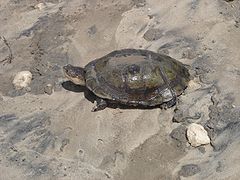
African helmeted turtle
Encyclopedia
The African helmeted turtle or Marsh terrapin (Pelomedusa subrufa), is typically a rather small turtle with most individuals being less than 87.9 cm in carapace length, but one has been recorded with a carapace length of 132.5 cm. it has an black or brown carapace
(shell). The tops of the tail and limbs are a grayish brown, while the underside is yellowish. The male turtle is distinguished by its long, thick tail. Females tend to have a shorter tail and a broader carapace. Hatchlings have a shell size of about 1 and 1/4 inches in length, and are olive to black in color. It also has two small tubercles under the chin and musk glands in the sides of the carapace. The African helmeted turtle doesn't have a hinged plastron (lower shell). All the other species in the family Pelomedusidae however have this feature which they can, using muscles, close to cover their head and front limbs.
and as far south as Cape Town
. It has also been found in Madagascar
and Yemen
. They are semi-aquatic animals, living in rivers, lakes, and marshes, and they also like rain pools and places that are fertilized.
The female will lay 2 to 10 eggs on average, normally during late spring and early summer. The eggs are placed in a flask shaped nest that is about 4 to 7 inches deep. The eggs hatch in 75– 90 days.

Carapace
A carapace is a dorsal section of the exoskeleton or shell in a number of animal groups, including arthropods such as crustaceans and arachnids, as well as vertebrates such as turtles and tortoises. In turtles and tortoises, the underside is called the plastron.-Crustaceans:In crustaceans, the...
(shell). The tops of the tail and limbs are a grayish brown, while the underside is yellowish. The male turtle is distinguished by its long, thick tail. Females tend to have a shorter tail and a broader carapace. Hatchlings have a shell size of about 1 and 1/4 inches in length, and are olive to black in color. It also has two small tubercles under the chin and musk glands in the sides of the carapace. The African helmeted turtle doesn't have a hinged plastron (lower shell). All the other species in the family Pelomedusidae however have this feature which they can, using muscles, close to cover their head and front limbs.
Diet
The African helmeted turtle is omnivorous and will eat almost anything. Some of the main items in its diet are insects, small crustaceans, fish, earthworms, and snails. They may also feed on carrion. The fine claws on its feet help it tear its prey apart. Groups of these turtles have been observed capturing and drowning doves when they come to drink.Habitat and Distribution
The range of Pelomedusa subrufa spreads over a large portion of Africa. It can be found as far west as GhanaGhana
Ghana , officially the Republic of Ghana, is a country located in West Africa. It is bordered by Côte d'Ivoire to the west, Burkina Faso to the north, Togo to the east, and the Gulf of Guinea to the south...
and as far south as Cape Town
Cape Town
Cape Town is the second-most populous city in South Africa, and the provincial capital and primate city of the Western Cape. As the seat of the National Parliament, it is also the legislative capital of the country. It forms part of the City of Cape Town metropolitan municipality...
. It has also been found in Madagascar
Madagascar
The Republic of Madagascar is an island country located in the Indian Ocean off the southeastern coast of Africa...
and Yemen
Yemen
The Republic of Yemen , commonly known as Yemen , is a country located in the Middle East, occupying the southwestern to southern end of the Arabian Peninsula. It is bordered by Saudi Arabia to the north, the Red Sea to the west, and Oman to the east....
. They are semi-aquatic animals, living in rivers, lakes, and marshes, and they also like rain pools and places that are fertilized.
Reproduction
Courtship is held all over the year. The male will follow the female nodding his head in front of hers. If she is non-responsive she will nip and snap and walk away. If she is willing, she responses nodding her head or just stands still, he can sit onto her. While mating both of the turtles shake their head.The female will lay 2 to 10 eggs on average, normally during late spring and early summer. The eggs are placed in a flask shaped nest that is about 4 to 7 inches deep. The eggs hatch in 75– 90 days.


